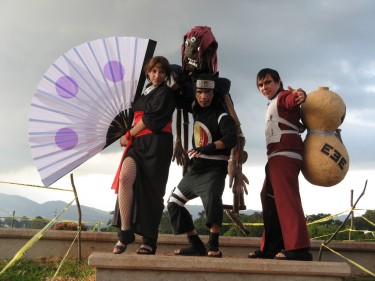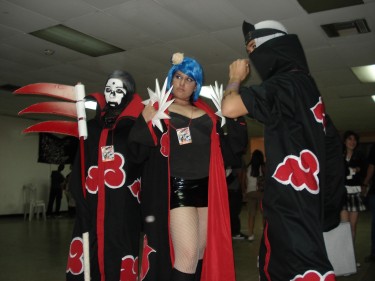Cosplay (costume play), is a way of expression in which participants use costumes and accessories to represent their favorite characters, usually from manga, anime or video games. Cosplay has followers all over the world and Latin America is not the exception.
The passion of its followers (Cosplayers) is reflected not only in their elaborate costumes, but also in their interest in promoting Cosplay and to share their own adventures through personal blogs, Facebook, Flickr and Twitter.

Cosplay Guatemala. Image by Jose Fernando, Flickr user Summon Baka. Used under a Creative Commons Attribution-Share Alike 2.0 Generic license.
Cosplay goes beyond dressing up in a costume. In the website Imperio Anime [es] from Costa Rica, Miroku explains what Cosplay is [es] and what it entails, clarifying:
Aunque no todo es vestirse; no. No se puede olvidar la parte ‘play’ de CosPLAY.
Gran parte de todo esto es pretender ser ese personaje al que se esté interpretando. Esto también es muy importante, además de divertido. Aunque solamente sea para una foto, o durante todo el evento o fiesta, o incluso para alguna dramatización; sin olvidar lo entretenido que puede resultar.
A big part of all this is to pretend to be the character that is being performed. This also is very important, besides being fun. Even if it is just for a photo, or during all the event or party, or even for just a dramatization; without forgetting how fun it can be.

Cosplay Panama. Sailor Moon. Image by Flickr user TulioPa. Used under a Creative Commons Attribution-non Commercial-non Derivs 2.0 Generic license.
The blog Cosplay Ecuador Elite [es] promotes Cosplay and interviews cosplayers from all over the world. The author has interviewed cosplayers from Italy, France, Mexico, Argentina, Panama, Peru and Chile, among others. In these interviews one can learn more about the concept, the work involved, the motivation of the cosplayers, their family's support and how complicated it becomes to store all those cosplays (costumes) when the collection is increasing.
The blogs and websites dedicated to Cosplay also approach some issues within the community.
In Costa Rica, Crys from the blog Cosplay de Costa Rica [es], wrote last year about the lack of humility that sometimes is shown by some cosplayers:
Ser un cosplayer de calidad, es un trabajo duro y que requiere mucho esfuerzo, nadie lo puede negar, pero últimamente algunos de estos cosplayer han tomado el titulo de *superiores* a otros cosplayer que no son tan buenos o si lo son pero simplemente quieren tratar de hacerse los importantes ante todos.
However the author clarifies that:
Hay muchos (por dicha son más) que son totalmente diferente; siempre se les ve escribiendo en los foros procurando hacer más emocionante el tiempo de espera de los aficionados que lo leen y anhelan con ansias los eventos, nunca niegan nada a nadie y lo mejor saben dar cumplidos a los otros participantes para así motivarlos más; creo que esa es la actitud que se debe tener ante las personas, que de cierta forma admiran el trabajo que los cosplayer realizan y mostrarce siempre agradecido ante ellos…
Nada Cuesta un Simple Gracias!! o sonreir ante los demas…
It is not that hard to give just a Simple Thank You!! or to smile at others…
Through their blogs, some cosplayers share the techniques used to make their costumes. In the blog Panama Cosplay Tutorials [es], the author explains in his posts how he accomplishes some elements in his cosplays. The last entry was for “Dr. Stein from Soul Eater” [es], where it is easy to appreciate the ingenuity used by cosplayers to get the effects that they are looking for. For example, Kohaku (nickname of the blog's author) explains how he built the head of the screw that this character uses:

Cosplay Panama-Dr. Stein. Image by Flickr user TulioPa. Used under a Creative Commons Attribution-non Commercial-non Derivs 2.0 Generic license.
Para la cabeza del tornillo yo use un plato de corn flakes de mi casa XD porque se ajustaba al tamaño de mi cabeza, les recomiendo que usen algo que no los haga verse desproporcionados, pueden sacarlos de una lamina de cielo raso o foam como les parezca.
Also from Panama, the blogs Konekotan [es] and Alatariel's Cosplay [es] [en] write about Cosplay and publish photos, videos, tips and events.
The blogs Bolivia Cosplay [es] and Myo Blog [es] also share photos that show Cosplay activities and events in Bolivia.
Myo Blog also offers Cosplay tutorials [es], and even one on how to make boots without boots [es]. Judging by the comments in this tutorial, her creativity benefited others and was received with a lot of gratitude.
The blog Amacosplay [es] from Venezuela also has some tutorials, as well as an entertaining description about her beginning in Cosplay and her growth as a cosplayer. In her blog [es], Ama or Meroko (nicknames of this cosplayer), has shared the happiness and difficulties of the cosplayer: raw material limitations, not having enough money and the satisfaction of the finished projects. Her last entry [es] shows how the economic realities of a country interfere with people's dreams and passions. Ama wrote:
Pues si ._. cada vez se pone más difícil la cosa, y em doy cuenta que de verdad vivía en una burbuja ._. ahora estamos sin agua, sin luz, sin dinero y sin comida ._. quiero hacer mis cosplays pero ahora cada vez pienso más que no podré hacerlos
In the same post she adds:
el futuro es tan incierto que me preocupa ._. y los planes que he hecho se han caído todos, siento como si no pudiera hacer más planes… ni siquiera tengo la menor idea de dónde estaré ni qué estaré haciendo dentro de 1 año… es suficiente para hacer que me preocupe
Cosplay Peru [es] is another specialized website and they have photos and videos about Cosplay in Peru as well as interviews and coverage of international events. Also from Peru, there is Guía Cosplay de Todos [es] which also promotes cosplay and showcases events and contests. Most recently they showcased Mister Cosplay and Cosplay Performance (group) contests.
In Mexico, the blog Exolimpo [es] covers many subjects, within them Anime, Manga and Cosplay. Related to Cosplay, they have written about the prejudices and negative criticism based on ignorance of what Cosplay entails, as well as the pros and cons of being a cosplayer. These subjects have been approached in two posts: “Cosplay: Waste of time and money?” [es] and “Cosplay: Madness?” [es].

Cosplay Panama. Image by Flickr user TulioPa. Used under a Creative Commons Attribution-non Commercial-non Derivs 2.0 Generic license.
Despite the fact that not every cosplayer has an active blog, it is evident that the Latin American community is significant and Cosplay has passionate followers around the region. In the interviews published by Cosplay Ecuador Elite [es], it is clear how much effort cosplayers put in their characters. At the end, it is more than just a costume; there is a lot of creativity, patience and work involved in accomplishing a successful Cosplay. At the same time, there is the process of learning their character in order to portray it during team performances.

Cosplay Venezuela – Narutards in Action. Image by Hector Cen, Flickr user Zentra. Used under a Creative Commons Attribution-non Commercial-Share Alike 2.0 Generic license.
Most of them put in many working hours and as Kiren explains in the post “Cosplay: Waste of time and money?” [es] there are several benefits that people can get out of cosplay: learn new things, make new friends, have fun and overcome shyness.







6 comments
Now, this is what Global Voices is all about – those stories you would never see anywhere else!
Fascinating! I agree 100% with Jillian.
Thanks for your comments. I am glad you enjoyed it.
I liked this, thanks for add me and the bolivian cosplay in your article!!
You are welcome Myo.
Hello. Thanks for such a great article. Its really awesome that this hobby is growing really quick. Thank you for taking interest, not just in my country Panama, but also with our other brothers and sisters countries in Latin America.
It is true that being a cosplayer has different meanings, ways and such… but I think that almost all cosplayers will agree at the end that after all the hard work, all those sleepless nights, money invested, time given in the manufacturing of cosplays and its props the result will reflect everything that they have done to get it all together; and the joy of sharing it with friends. :)
Also, its true that no everyone can do their own blogs and stuff (I have one, however my job and studies won’t let me update it as much as I’ll like), but they can also help by giving tips and guides of how to do’s or doing some stuff themselves for others. The thing is, that if you can and know how, don’t feel shy towards giving that helping hand to others and always giving them your support. As I always say: ”You go!”
Thank you once more.
xoxo